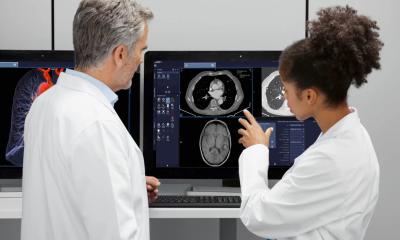The integration of artificial intelligence (AI) into healthcare workflows is a critical step toward enhancing efficiency, decision-making, and productivity for small and medium-sized businesses (SMBs) in the medical field. As healthcare institutions increasingly adopt AI technologies, understanding how to implement these innovations can dramatically improve operational processes. This involves recognizing the tools available, such as MONAI Deploy, and how they can optimize various aspects of medical imaging.
At recent industry conferences, significant demonstrations of AI advancements revealed that esteemed companies like Siemens Healthineers are leveraging tools that facilitate the integration of AI into clinical environments. By adopting MONAI Deploy—a module within the MONAI platform—Siemens Healthineers is able to bridge the often-challenging gap from research to clinical production. This tool is designed to boost both the speed and efficiency of integrating AI workflows into everyday clinical practices, making it easier for healthcare professionals to glean insights from medical imaging.
One of the pivotal challenges that developers face when building AI applications is the multitude of frameworks that can complicate deployment into clinical settings. This fragmentation can lead to delays and inefficiencies, which are detrimental in a field where timely decisions can alter patient outcomes. Herein lies the value of using a robust tool like MONAI Deploy. By enabling users to build AI applications that can run anywhere with just a few lines of code, it streamlines the development cycle. SMBs can utilize this advantage by equipping their teams with MONAI Deploy to not only construct but also package and test their medical AI applications more efficiently.
The implications of such efficiencies are profound. According to industry leaders, the MONAI Deploy tool has substantially accelerated the AI integration process. Users can port trained AI models into real-world clinical settings with just a few clicks, reducing timelines from months to a matter of days or even hours. For SMBs, this acceleration means that they can bring their cutting-edge innovations to market faster, ensuring that radiologists and healthcare professionals have quicker access to sophisticated imaging insights. This is not just a theoretical exercise; it is a practical benefit that can translate directly into improved patient care, as well as cost savings.
For small to medium healthcare businesses, the implementation of AI-driven workflows can optimize routine tasks that consume significant time and resources. For instance, in the realm of medical imaging, integrating AI can minimize the manual labor involved in image analysis, which is traditionally time-consuming. The ability to automatically analyze images and flag anomalies allows radiologists to focus on interpreting results rather than sifting through data. This not only enhances diagnostic accuracy but also frees up valuable time to attend to more patients or focus on complex cases.
Moreover, integrating AI in daily operations enables better decision-making by providing clinical staff with enhanced data analytics tools. For instance, implementing a comprehensive AI tool to analyze patient data can help healthcare providers identify trends and patterns that may not be immediately evident. This leads to proactive patient management and more informed clinical decisions, ultimately improving patient outcomes and satisfaction. SMB leaders should consider investing in AI capabilities not just as a technological upgrade but as a strategic move that aligns operational processes with modern medical practices.
The return on investment (ROI) for integrating AI into healthcare workflows is promising. It is essential for SMBs to look beyond the initial installation costs and consider the long-term financial benefits that these technologies can provide. With faster diagnosis times, improved operational efficiencies, and enhanced patient experiences, the returns on up-front investments can accumulate rapidly. Additionally, the ability to attract and retain clients grows as healthcare providers become recognized for providing quicker and more accurate results, adding to the bottom line.
In summary, the integration of AI-driven workflows and automation strategies into daily operations is not merely a trend but a transformative approach for small and medium businesses in healthcare. By leveraging tools like MONAI Deploy, these organizations can significantly enhance operational efficiency, decision-making capabilities, and overall productivity. As the landscape of medical technology continues to evolve, embracing AI will position SMBs not only as participants but as leaders in delivering innovative healthcare solutions.
FlowMind AI Insight: The swift integration of AI into daily operations heralds a new era for healthcare SMBs, combining innovation with efficiency. By adopting targeted AI tools, businesses can not only streamline workflows but also unlock new opportunities for growth and patient care excellence.
Original article: Read here
2024-12-04 08:00:00

